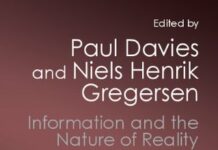
Ebook Info
- Published: 1984
- Number of pages: 255 pages
- Format: PDF
- File Size: 15.63 MB
- Authors: Paul Davies
Description
Superforce: The Search for a Grand Unified Theory of Nature.
User’s Reviews
Reviews from Amazon users which were colected at the time this book was published on the website:
⭐I thoroughly enjoyed this book. It goes a little too in depth into some basic mathematical concepts. Anyone reading this book should already have a grasp of simple elementary mathematical concepts. I didn’t think that was necessary. Some of the other concepts are a bit hard to understand, such as his symmetry argument and, of course, relativity and quantum theory, which he does not really try to explain very much, but who can? This is a great introduction to particle physics. I was able to conceive of the color force for the first time. I could actually see the quantum foam! And, the higgs bosons actually made sense for a moment, but for just a moment. I loved this book and would recommend it to anyone interested in particle physics and the deeper nature of reality: electromagnetism, gravity, weak/strong interactions–THE FORCE!
⭐Paul Davies is tackling a difficult subject, for sure. Davies is no James Michener, compelling and gripping are not words I would use when describing this book. The author has been able to take a boring subject and make it more boring. Unfortunately, the book lacks conclusions about a grand unifying force, and is more of an encyclopedic overview of the various theories in modern day physics.
⭐Very nice book. The last paragraph of the book is very interesting.
⭐Noble physics laureate Abdus Salam calls this book “heady stuff” and says, “Davies has established himself as one of the most felicitous writers on physics at the frontier.”Over the years I’ve become something of a Paul Davies connoisseur, having read many of his books. Among noted scientists writing popularizations, Davies is the reigning gold-standard. This is the best of his early works. When it was published in 1984, Davies had achieved some acclaim for his previous book ‘God and the New Physics’ but ‘Superforce’ is a far superior work (GatNP was perhaps his worst book). Superforce is not only one of Davies best books, in some ways it’s one of the best physics popularizations ever published. Although the thesis is the deepest [expected] ‘law’ of nature (the superforce, supersymmetry, unified field, ToE, GUT, call it what you will) the first three chapters are as concise an explanation of quantum theory as a novice could hope for. If you don’t get a glimpse of the “weird” quantum world from the first 50 pages, you probably never will (“The apparently concrete matter of experience dissolves away into vibrating patterns of quantum energy”). Perhaps the most significant consequence of the quantum theory is the insight that mind is a fundamental component of our world, not, as some had expected, a secondary phenomenon arising from mere mechanism. And Davies’ exposition has just begun.With the groundwork established, Davies begins toward the heart of the matter in chapter four, exposing mathematical and gauge symmetries and the fascinating role of aesthetics, i.e., beauty, in nature (and thus in theoretical physics). Treated next are; the four supposedly fundamental forces, the particle “zoo” including messenger particles, QED, and the not-so-empty vacuum populated with “temporary particles whose visit is financed by the Heisenberg loan.” And then a return to symmetry — and hidden symmetries and symmetry breaking. Moving forward systematically, the going gets tougher. With electricity, magnetism, and the weak nuclear force mathematically combined, the next force to be included in the expected ‘superforce’ is the strong (glue) force, and this presents several problems, to put it mildly. Davies discusses the challenge of developing gauge field theories for quarks and gluons and how it has been met by QCD (quantum chromodynamics). With the expectation of a GUT now explained, what remains is to look at the contending variations (to explore the precise fit of QCD in a GUT by way of direct experiment, “we should have to build an accelerator larger than the solar system”, to experimentally establish a GUT complete with gravitation, we would have to construct an accelerator larger than our galaxy!). Obviously mathematics is now the only tool available.Having already explained how the quantum theory has dispelled prospects for a strict reductionism wholly succeeding, Davies now develops the argument (chapters 9 – 12) that a single physical theory will eventually explain, yes — everything (sort of). If this apparent turnabout has your head spinning, well, Davies isn’t finished. He goes on finally to explain that such a theory of “everything,” astounding and useful as it may be, has little, if any, hope of actually being an explanation of everything (chap 14). Like Stephen Hawking and perhaps most theoretical physicists in 1984, Davies anticipated a more or less completed Grand Unification Theory within a few years.When Davies wrote this book it was cutting edge stuff, reporting and analyzing very recent developments. Of course, a few things are now a bit dated: Davies (in 1984) expected that the universe was 18 billion years old, while something like 12 to 13 billion is now thought. And at one point he says that ‘evidence’ indicates “Earth is a typical planet.” This was a particularly popular view 20 years ago, but today I think Davies view is rather different, amenable to better and more recent data (see, for example, the books ‘Rare Earth’ and ‘The Privileged Planet’). But most of the science here is still accurate (and “literally boggles the mind”). The discussion of the relationship of thermodynamics to the ‘rolled up’ dimensions of string theory in the context of the early universe is excellent.In the concluding chapter, Davies asks if there is a ‘cosmic plan’ and if so what is then implicit. “The new physics and the new cosmology hold out a tantalizing promise; that we might be able to explain how all the physical structures in the universe have come to exist . . . as a result of natural processes. . . Nevertheless, though science may explain the world, we still have to explain science. The laws which enable the universe . . . seem themselves to be the product of exceedingly ingenious design. If physics is the product of design, the universe must have a purpose, and the evidence of modern physics suggests strongly to me that the purpose includes us.” All in all, this is one of Davies’ best books. Five solid stars, even if a final GUT is not as closely anticipated as it was in the 80’s, even if not quite perfect, and even after 20+ years.© wes janssen
⭐Davies has managed a masterly survey of modern physical theory. He covers a lot of area, so the treatment of some topics is brief. Always the teacher, he props up concepts with good models and examples. Davies has, in this and other books, registered as one of the best explainers of quantum concepts. Superforce includes an engaging description of the importance of mathematics as the language of physics. It also explains why some slightly opaque terms such as `fields’ and energy’ are useful in explaining physics mathematically.
⭐This is an astonishingly lucid and consistently fascinating look at the scientific search for the single force that is purported to unite all the forces of nature – the reader gets a review of the known forces as well as the new ideas emerging from chaos and complexity theories. Davies is one of the great popularisers who NEVER indulges in hype or wild speculation, but instead sticks to the science. While his books may seem austere, they are clearer and more precise than a myriad of other science writers, who puff up meagre results with pseudo-science.Warmly recommended.
Keywords
Free Download Superforce: The Search for a Grand Unified Theory of Nature in PDF format
Superforce: The Search for a Grand Unified Theory of Nature PDF Free Download
Download Superforce: The Search for a Grand Unified Theory of Nature 1984 PDF Free
Superforce: The Search for a Grand Unified Theory of Nature 1984 PDF Free Download
Download Superforce: The Search for a Grand Unified Theory of Nature PDF
Free Download Ebook Superforce: The Search for a Grand Unified Theory of Nature


